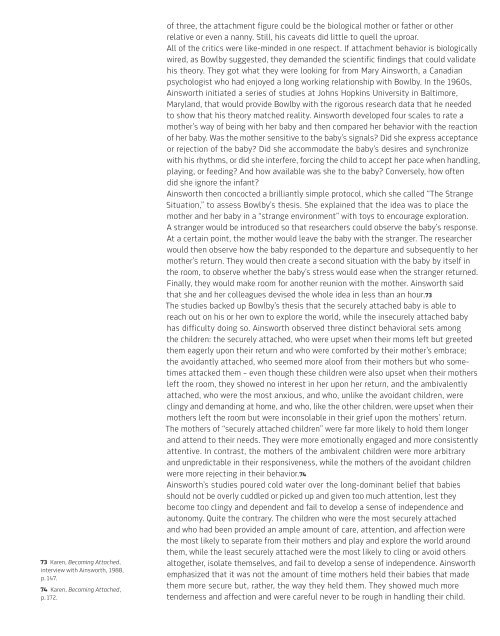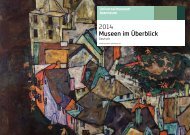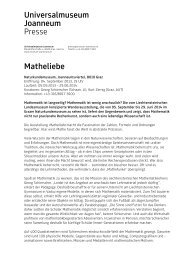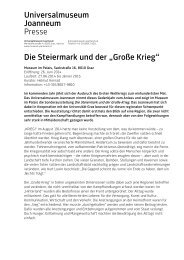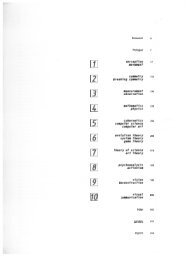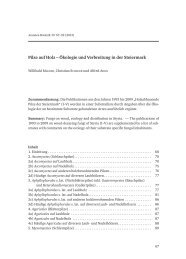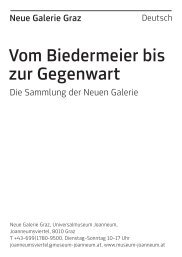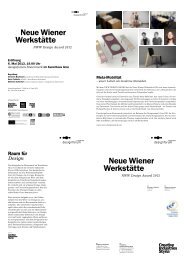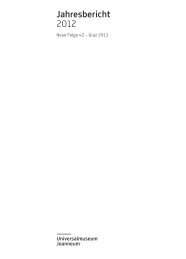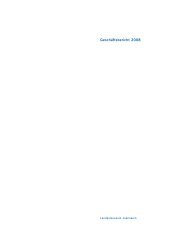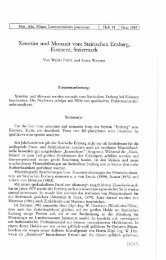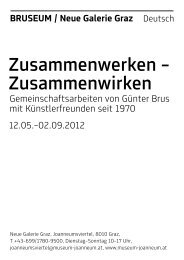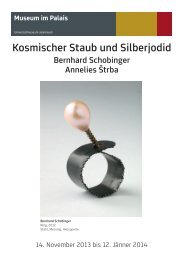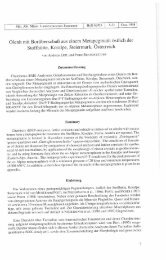Human Condition - Universalmuseum Joanneum
Human Condition - Universalmuseum Joanneum
Human Condition - Universalmuseum Joanneum
Sie wollen auch ein ePaper? Erhöhen Sie die Reichweite Ihrer Titel.
YUMPU macht aus Druck-PDFs automatisch weboptimierte ePaper, die Google liebt.
73 Karen, Becoming Attached,<br />
interview with Ainsworth, 1988,<br />
p. 147.<br />
74 Karen, Becoming Attached,<br />
p. 172.<br />
of three, the attachment figure could be the biological mother or father or other<br />
relative or even a nanny. Still, his caveats did little to quell the uproar.<br />
All of the critics were like-minded in one respect. If attachment behavior is biologically<br />
wired, as Bowlby suggested, they demanded the scientific findings that could validate<br />
his theory. They got what they were looking for from Mary Ainsworth, a Canadian<br />
psycholo gist who had enjoyed a long working relationship with Bowlby. In the 1960s,<br />
Ainsworth initiated a series of studies at Johns Hopkins Uni versity in Baltimore,<br />
Maryland, that would provide Bowlby with the rigorous research data that he needed<br />
to show that his theory matched reality. Ainsworth developed four scales to rate a<br />
mother’s way of being with her baby and then compared her behavior with the reaction<br />
of her baby. Was the mother sensitive to the baby’s signals? Did she express acceptance<br />
or rejection of the baby? Did she accommodate the baby’s desires and synchronize<br />
with his rhythms, or did she interfere, forc ing the child to accept her pace when handling,<br />
playing, or feeding? And how available was she to the baby? Conversely, how often<br />
did she ignore the infant?<br />
Ainsworth then concocted a brilliantly simple protocol, which she called “The Strange<br />
Situation,” to assess Bowlby’s thesis. She explained that the idea was to place the<br />
mother and her baby in a “strange envi ronment” with toys to encourage exploration.<br />
A stranger would be introduced so that researchers could observe the baby’s response.<br />
At a certain point, the mother would leave the baby with the stranger. The researcher<br />
would then observe how the baby responded to the depar ture and subsequently to her<br />
mother’s return. They would then create a second situation with the baby by itself in<br />
the room, to observe whether the baby’s stress would ease when the stranger returned.<br />
Finally, they would make room for another reunion with the mother. Ainsworth said<br />
that she and her colleagues devised the whole idea in less than an hour.73<br />
The studies backed up Bowlby’s thesis that the securely attached baby is able to<br />
reach out on his or her own to explore the world, while the insecurely attached baby<br />
has difficulty doing so. Ainsworth observed three distinct behavioral sets among<br />
the children: the securely attached, who were upset when their moms left but greeted<br />
them eagerly upon their return and who were comforted by their mother’s embrace;<br />
the avoidantly attached, who seemed more aloof from their mothers but who sometimes<br />
attacked them – even though these children were also upset when their mothers<br />
left the room, they showed no interest in her upon her return, and the ambivalently<br />
attached, who were the most anxious, and who, unlike the avoidant children, were<br />
clingy and demanding at home, and who, like the other children, were upset when their<br />
mothers left the room but were inconsolable in their grief upon the mothers’ return.<br />
The mothers of “securely attached children” were far more likely to hold them longer<br />
and attend to their needs. They were more emotion ally engaged and more consistently<br />
attentive. In contrast, the mothers of the ambivalent children were more arbitrary<br />
and unpredictable in their responsiveness, while the mothers of the avoidant children<br />
were more rejecting in their behavior.74<br />
Ainsworth’s studies poured cold water over the long-dominant belief that babies<br />
should not be overly cuddled or picked up and given too much attention, lest they<br />
become too clingy and dependent and fail to develop a sense of independence and<br />
autonomy. Quite the contrary. The children who were the most securely attached<br />
and who had been provided an ample amount of care, attention, and affection were<br />
the most likely to separate from their mothers and play and explore the world around<br />
them, while the least securely attached were the most likely to cling or avoid others<br />
altogether, isolate themselves, and fail to develop a sense of independence. Ainsworth<br />
emphasized that it was not the amount of time mothers held their babies that made<br />
them more secure but, rather, the way they held them. They showed much more<br />
tender ness and affection and were careful never to be rough in han dling their child.


